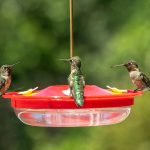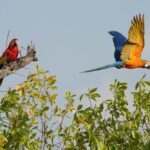Installing a nest box, or two, or more, offers increased nesting opportunities for local birds.
There are a few things to keep in mind that a person can do to increase the chances that birds will nest in your yard.
To attract birds to a nest box, research different species of birds to determine nesting preferences. Then do the following:
- Choose a box with the right-sized hole, an access panel, a sloped roof, interior grooves, and no exterior perches.
- Mount the nest box in a location with ample food and water sources, but away from harsh weather patterns and noisy environments.
- Secure the nest box at least 5 feet from the ground to help keep predators away.
- Do not use herbicides or pesticides in your yard.
- Maintain and clean the nest boxes for a secure and germ-free box.

Read on to learn more about the birds that build in nest boxes, and detailed information about how to attract birds to them.
Birds Attracted To Nest Boxes

There are 14 types of bird’s nests, and about 85 species in North America make nests inside cavities.
These holes can be found in decaying wood, trees, gaps or cracks in structures, or birdhouses (nest boxes). Some species excavate cavities, while other species use what they can find.
Depending upon the species, cavity-nesting birds will use the hole as-is or line it with soft nesting materials such as grasses, moss, and fur. The size of the cavity that a bird needs is also species-dependent.
Birds that will use a nest box include, but are not limited to, the following:
- Chickadees (Paridae)
- Finches (Fringillidae)
- Sparrows (Passeridae)
- Flycatchers (Tyrannidae)
- Warblers (Passeri)
- Nuthatches (Sitta)
- Swallows (Hirundinidae)
- Woodpeckers (Picidae)
- Wrens (Troglodytidae)
- Tufted titmouse (Baeolophus bicolor)
- Eastern bluebird (Sialia sialis)
- European robin (Erithacus rubecula)
5 Tips For Attracting Birds To A Nest Box
1. Choosing The Right Nest Box

Birds will opt for a natural nesting cavity, but if a birdhouse, or nesting box, is appealing to a particular species of bird, they will settle in.
When purchasing (or building) a commercial nest box, refer to the label. The function of a birdhouse is the top priority for successful nesting, rather than the overall exterior appearance.
Birdhouses contain features and designs for particular species of birds.
In most cases, this is to accommodate the size of the bird, giving it ample space to construct a nest, and protect the eggs and hatchlings.
Regardless of the species, an appropriate nest box should include the following:
- Made of natural, untreated wood (such as pine)
- Outer wood thickness of ¾-inch or more for insulation
- Entrance hole for the species to get in (size varies depending on species; small enough to keep predators out)
- No exterior perches (to keep predators out)
- Entrance hole that is about an inch lower than the center (providing space for a nest to be built)
- Extended, sloped roof to keep precipitation out
- Recessed floor with drainage holes and ventilation holes to keep inside dry and cool
- Rough, grooved interior walls for hatchlings to exit
- A top or side movable panel to clean the birdhouse out (after use)
2. Mount A Nest Box In The Right Conditions
Time Of Year

A nest box should be mounted before the breeding starts. This can vary by region and species.
Generally, a nest box or birdhouse should be mounted between February and March.
If a box is left up year-round, it may be used as cover or shelter by some species.
Keep in mind that it can take time (sometimes years) for birds to start using a box. Leaving it up year-round may help birds to acclimate to it more quickly.
Mounting Location: Height, Directional Position, Surrounding Area

Nest boxes should be mounted on sturdy supports, such as a pole, wall, fence post, or tree.
Most cavity nesters like stable nest boxes, with the expectation of wrens and purple martins which will nest in hanging ones.
Predator baffles, dome or pole-shaped, can be installed above and below the house to help guard the nest box and deter other creatures from climbing and getting in.
If you are aiming to attract a particular species of bird, research its habitat and nesting preferences.
Height

The height at which different species of birds nest varies. Refer to the label on a purchased box or contact a local cooperative extension or wildlife refuge for this information.
Generally, bird boxes should be at least 5 feet up off of the ground to help keep ground predators, such as cats or raccoons, out.
Keep in mind that the birdhouse will need to be monitored and cleaned out, so make sure you can still access it. If a ladder is required, ensure that the ground below is stable enough to support it.
Directional Position

Take note of wind patterns in your area, as well as spots that receive lots of direct sunlight. Birds will avoid boxes that have holes facing into strong winds.
Mount the nest box so that the entrance hole faces away from winds, which protects the hatchlings and the interior from damp and cold conditions.
Nest boxes in direct sunlight will get too hot on the interior. Choose a spot that allows for some partial sunshine to warm the box.
Surrounding Area

Cavity birds will need some privacy, so keep the following in mind:
- To encourage more than one species of bird to visit your yard, you can install more than one birdhouse.
- However, you should place birdhouses at least 15 to 25 feet apart from each other to prevent territorial issues.
- Bird houses are more likely to be used if they are placed away from foot traffic, bird feeders, windchimes, bird baths, and any other clutter.
- A clear and quiet flight path to the nest box gives the young family privacy and a sense of security.
- Mounting the nest box in a sheltered area gives the parent birds the ability to rest on nearby branches.
- It also protects the birdhouse from extreme temperatures and precipitation.
- Consider letting one part of your yard grow in a wild fashion with trees and bushes.
- Thicket-like areas will have native plants and trees that give the birds nesting materials such as twigs, plant material, grass clippings, bits of leaves, and mosses.
3. Monitoring And Cleaning The Nest Box

Monitor the nest box for activity during the breeding season, which is typically spring, but varies depending upon the species.
You will notice mature birds darting in and out as they build or feed hatchlings. If you notice a decrease in activity, you can see if the birds have left the nest.
To do so, lightly knock on the birdhouse, taking care not to put your face directly in front of the hole. Limit knocking to once a week to reduce any potential disruptions.
You can also listen to see if you hear the young chirping.
Many cavity nesters build new nests for each brood. Cleaning will remove parasites, diseases, mold, and mildew from the box.
Remove the empty nest and clean it out with mild, soapy warm water, using unscented dish detergent.
Rinse the nest box clean with boiling water. Allow it to fully air dry.
A cavity nester may use the nest box again before the season is over.
If you leave a nest box up year-round, clean it again right before the breeding season to encourage birds to move in with a new, fresh nest.
Check the box for any damage and replace it if needed, mounting it in the same location.
4. Avoid The Use Of Herbicides And Pesticides

Do not place a birdhouse where herbicides and pesticides are being used.
These decrease the bird’s food supply, as well as contaminate potential nesting materials such as plant material and spider silk.
These chemicals can also harm birds directly, especially if they consume chemically-coated plant food, insects, and spiders.
5. Have Readily Available Food And Water Sources Nearby

Cavity nesters are more likely to build a nest when there are readily available food sources nearby.
Hang up bird feeders and bird baths on the other side of your yard away from the nest box. This keeps the noise level down, but also offers a food source.
Offer a variety of foods such as seeds, suet, and mealworms to attract a variety of birds.
Benefits Of Nest Boxes

Nest boxes are beneficial to cavity nesters and their survival.
Birds can struggle to find suitable nesting places when damaged and dead trees are removed.
Trees are often moved from places where people live or for new construction, which then removes cavity nesting opportunities for birds.
Additionally, invasive species such as the European starling (Sturnus vulgaris) and house sparrow (Passer domesticus) are cavity nesters, taking spots that native birds need as well.
By setting up bird boxes around your home, you offer more opportunities for birds to settle in, raise their young, and thrive.
This video shows a bluebird (Sialia sialis) building a nest:
In Conclusion
By knowing species-specific information about the nesting habits and preferences of birds you can set your yard up for success.
Attracting birds to a nest box involves installing a nest box that is at the right height, facing a position away from strong winds and harsh sunlight, and made with the right design in regards to its hole and interior.
Nest boxes mounted away from foot traffic, bird feeders, bird baths, and other distractions are best for offering a quiet and restful place to raise hatchlings.
Your nesting area should be free from herbicides and pesticides while offering natural and native nesting materials such as moss, grass clippings, bushes, pine needles, and twigs.
Regular maintenance and cleaning of nest boxes will also encourage birds to build there year after year.











![Do Birds Use Birdhouses In Winter? [How To See Birds All Year Long] Do Birds Use Birdhouses In Winter? [How To See Birds All Year Long]](https://birdchronicle.com/wp-content/uploads/2022/10/bird-feeder-in-snowy-winter-150x150.jpg)
